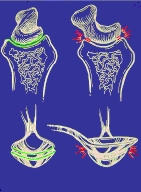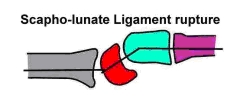The wrist comprises three separate joints.
The radiocarpal and midcarpal Joints allow the wrist to move up and down, and side-to-side. (Flexion / Extension / Deviation)
The distal radio-ulnar joint allows the forearm and hand to rotate. (Pronation / Supination).


The wrist is supported by a complex arrangement of ligaments. The ligaments not only thicken and strengthen the surrounding joint capsule but also provide linkages between the many bones that make up the wrist.
Thickenings of the capsule are called extrinsic ligaments. Ligaments joining the bones together inside the joint are called intrinsic ligaments.
The most important intrinsic ligament in the wrist is the scapholunate ligament. It is analogous to the cruciate ligament in the knee. It supports the scaphoid bone linking it to the lunate bone. In turn the scaphoid bone supports the midcarpal joint.
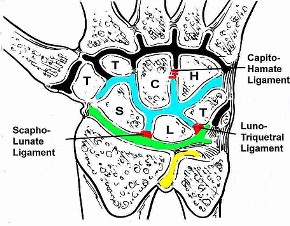
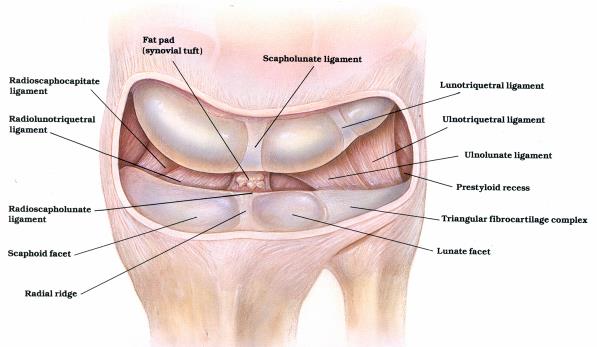
A tear of the scapholunate ligament allows the scaphoid to rotate abnormally during wrist motion. The scaphoid no longer supports the inherently unstable midcarpal joint and hence a collapse pattern develops across the midcarpal joint.
The joint between the scaphoid and radius is like having 2 spoons sitting on top of one another. They fit together in a congruent fashion allowing even transfer of forces across the joint. If the scaphoid rotates abnormally this congruent relationship is lost. It is like putting 2 spoons on top of each other at right angles. There is a very poor fit. The area of contact is only small and so the forces across the contact points increase. Abnormal movements of the scaphoid can create a clicking sensation in the wrist. These movements can result in scuffing of the now incongruent joint surfaces, which over time may lead to arthritis in the wrist.
Scapholunate Ligament Rupture - Issues
Many of the issues considered are inter-related
Age
Quality of the torn ligament - Is it repairable?
Degree of stretching of ligaments around the scaphoid - especially the Scaphotrapezial capsule
Duration since injury
Is the scaphoid reducable or has it developed a fixed deformity
Degree of Arthritis
Level of disability
- Pain
- Weakness
- Giving way
Consequences of Scapholunate ligament Rupture
A rupture of the Scapholunate ligament occurs in 2 major settings
- High energy trauma
- Degenerative rupture – often minor trauma, or
- Combination of the above
Many people present late because they think the wrist is only “Sprained” or the initial Xrays are normal.
The initial changes on Xray can be very subtle.
The effect on the wrist depends on the laxity or associated injury to the Extrinsic ligaments. If these are lax then a rupture of the S-L ligament results in significant wrist malalignment and hence increases the risk of long term arthritis. If they are tight there may be no discernable change in wrist alignment especially early after the injury.
In general a rupture of the ligament will eventually result in wrist arthritis. This follows a predictable pattern affecting the radio-scaphoid joint first then the midcarpal joint later. Patients often notice pain on the thumb side of the wrist.
Wrist alignment



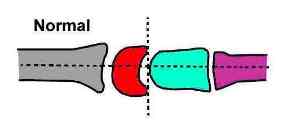
Investigations
- Bilateral wrist Xrays
- M.R.I scan
- Arthroscopy
Treatment Options
- Cast +/- K wires if partial tear
- Brace
- Direct repair
- Dorsal capsulodesis
- Ligament reconstruction using:
- CapitoHamate ligament ( Bone / Ligament / Bone) or
- FCR tendon - Modified Brunelli Procedure
- Ross Procedure
- Treatment for the arthritis
Wrist Arthroscopy

Fluid is pumped into the wrist to allow insertion of the arthroscope. This separates the joint surfaces. Open wrist operations such as ligament reconstructions are often delayed until the swelling from the fluid instilled into the joint has settled. This may take 2 to 3 weeks.
See Wrist Arthroscopy handout sheets
Ligament Repair
If seen early the deformity / malalignment of the carpal bones can be corrected. If the ligament is not shredded it can be re-attached to the bone (usually the Scaphoid) using small bone anchors.



The carpal bones are held in position while the ligament heals with wires which are inserted from the thumb side of the wrist through a second small incision. These wires are removed after 8 – 10 weeks at a second operation.
After ligament repair the wrist is immobilised in a cast for 8 weeks then a wrist brace for 4 more weeks. Gentle exercises are begun at 8 weeks but grip strengthening is not begun before 12 weeks. Contact sport should be avoided for at least 6 months.
Dorsal Capsulodesis
The ligament repair is often reinforced with a transfer of the ligaments on the Dorsal side ( Back) of the wrist. This reinforces the ligament repair and also helps correct the rotational malalignment of the scaphoid and lunate. It does not alter the rehabilitation process.
For Step by step description of the Operation click on the LINK




Bone ligament Bone Reconstruction
If the Scapho-lunate ligament is shredded or degenerate then it can be reconstructed using another ligament in the wrist which can be sacrificed. The Capitate bone is held tightly to the Hamate bone by multiple ligaments. The CapitoHamate ligament can be used to reconstructed the S-L ligament using 2 attached bone blocks. A trough is drilled in the Scaphoid and lunate to accept the transfer which is held in place with 2 small screws. The ligament reconstruction is also reinforced with wires for 8 weeks.
For Step by step description of the Operation click on the LINK

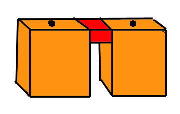
Modified Brunelli Procedure
If the Ligament is non repairable and there has been stretching of the wrist capsule , particularly between the scaphoid & the Trapezium a Modified Brunelli Reconstruction is indicated. This involves using the FCR tendon to reconstruct the Scapholunate Ligament .
For Step by step description of the Operation click on the LINK
LAST UPDATED ON 12 / 4 / 2015



